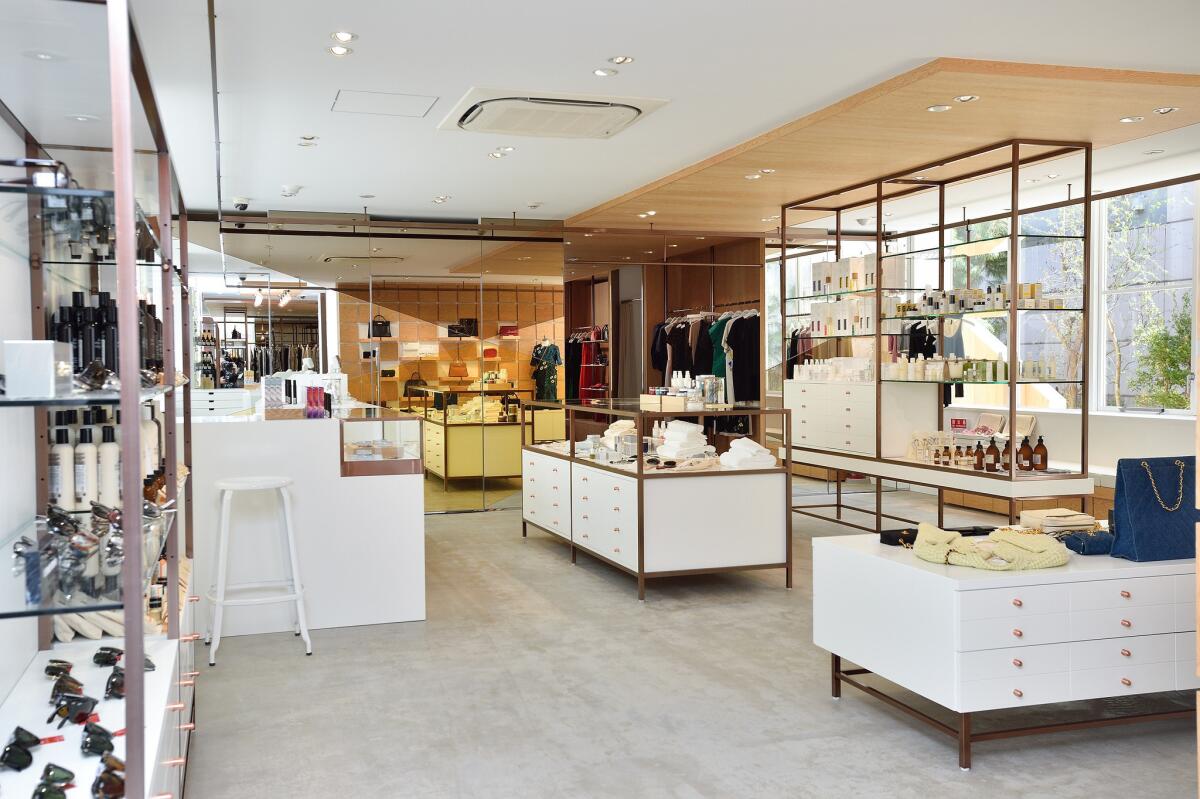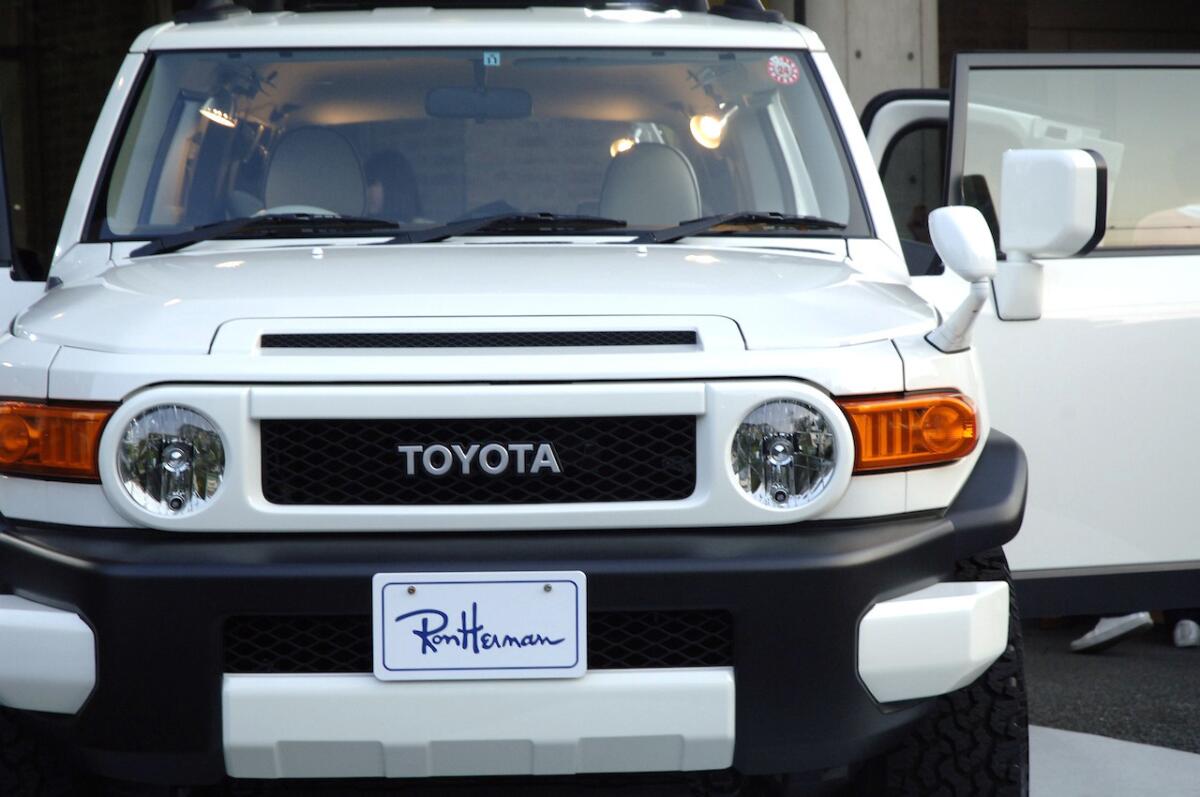L.A. fashion retailers hit it big in Japan: How Ron Herman and others do it

A three-building Fred Segal center opened its doors in Tokyo’s Daikanyama neighborhood in April of 2015.
- Share via
Since the earliest days of Hollywood, Southern California has been a champion exporter and influencer of popular culture, first with movies and television shows sent to every corner of the globe and later with surf trunks, skate shoes, premium denim, Von Dutch trucker hats and the curious creation that was the Juicy Couture velour tracksuit.
So it follows that over the last decade and a half, a growing number of retailers that have shaped the SoCal style scene have become bankable, exportable brands themselves. The most recent example is American Rag Cie, which late last month opened a flagship store in Shanghai (the first of many planned stores in the Chinese market).
"It's no surprise that L.A.-based retailers are finding success globally," says Tom Julian, men's fashion director at the Doneger Group, a New York City-based retail and merchandising consulting firm. "L.A. retailers have been creative visionaries, as well as contemporary curators of a warm-weather lifestyle that today can be embraced in any international city, especially those in Japan and Hong Kong. That lifestyle has also moved beyond apparel and into architecture [and] design."
Interested in the stories shaping California? Sign up for the free Essential California newsletter >>
Julian says there are some powerful factors working in favor of L.A. retailers looking to expand internationally. One is the ability to "leverage the cultural cues of beach life, celebrity life and athletic life." A second is a seasonless L.A. look, and a third is simply the way they merchandise the goods they sell.
"L.A. retailers have always understood how to take iconic American items like T-shirts, jeans, sneakers and leather jackets and mix them in a modern way for young shoppers as well as [for] international style mavens," he says.
Ilse Metchek, president of the California Fashion Assn., a group representing the state's textile and apparel businesses, puts it another way. "The word 'California' is simply a selling point," she says, "New York does not have that. You never hear of anyone talking about a 'New York lifestyle.'"

American Rag Cie recently opened a flagship store in Shanghai, China.
While the far-flung outposts share DNA with their stateside forebears, Ron Herman (who has a baker's dozen self-named boutiques in Japan) says the retail experience in these distant ports is anything but SoCal cookie-cutter.
"The Japanese customer doesn't need palm trees or surfboards. They don't need board shorts," says Herman. "What they do appreciate is a passion for specialty store retail … and a cultural environment."
Herman should know what he's talking about. In the U.S. he has a reputation as an extremely influential retailer (albeit one with a relatively small bricks-and-mortar footprint of just three stores, on Melrose, in Malibu and Brentwood). In Japan he's grown into a full-fledged lifestyle brand, a la Ralph Lauren — customers can drive Ron Herman Toyotas, get facials in a Ron Herman spa and have their wedding receptions catered by a Ron Herman Cafe.
Here's how a few of the brands that helped shape L.A.'s retail landscape are doing things differently overseas.
Your 15 essential L.A. looks for fall
Fred Segal
In 1961, a young entrepreneur by the name of Fred Segal touched off the first wave of designer denim mania in L.A. Four years later he opened what would be his branding legacy: the original shop-in-shop concept. Acting as landlord, Segal clustered a cadre of cutting-edge, independent retailers under one Melrose Avenue roof and the Fred Segal Center concept was born. In 2012, the Segal family (Fred had long retired) sold the intellectual property rights to the brand to Sandow, which sees opportunity in international expansion.
Goods: Segal's Melrose and Santa Monica locations (not part of the Sandow deal) were incubators of famed retail brands including Ron Herman and Ron Robinson, and the mix of retail and restaurant offerings created an environment that generations of shoppers wanted to not only visit but spend money in.
International presence: The first non-U.S. outpost for the brand, a three-building complex known as Fred Segal Daikanyama, opened in Tokyo in April. In a nod to its L.A. origins, it has a food truck out front and ivy-covered walls.
Popular overseas: According to Fred Segal CEO Paul Blum, designer sneakers and denim have been strong since the complex opened, and he describes the vintage handbag business as "a runaway success." But Blum says one product — from the food offerings, not fashion — has been the biggest hit so far: bottles of Fred's Brew, a private-label cold-brewed coffee. "They can't seem to get enough of it over there," says Blum. "It's taken us kind of by surprise."
American Rag Cie
Mark Werts opened his first American Rag store in San Francisco in late 1984, followed by a Los Angeles boutique in November of 1985. An expanded version of that L.A. flagship still fronts La Brea Avenue.
Goods: Heavy on the vintage offerings and renowned for an extremely deep bench of denim, the American Rag stores in L.A. and Newport Beach also serve up an eclectic, high-low mix of workwear, sportswear, housewares and accessories.
International presence: "We had a store in Paris sometime in the 1980s," says Werts, "but the Tokyo boutique we opened in 1997 was the first deeply successful international store." Today there are 13 Japanese stores, one each in Jakarta, Indonesia, and Bangkok, Thailand, and a 6,500-square-foot store that opened in Shanghai in late July. It's the first of many stores planned for the Chinese market.
Popular overseas: "[The stock is] similar but edited to the local market. There are certainly climatic variations for the local markets — in Bangkok a cold winter day is 84 [degrees] and for 11 months out of the year it's 95 [degrees], so heavy jackets would not be an item other than for a Russian tourist," Werts says. "We sell a general concept of what we call California lifestyle and folks overseas have an idea of what that means. We're certainly more denim-based than some other [retailers]."
See the most-read stories this hour >>
Kitson
Canadian expat Fraser Kitson Ross opened his first Kitson boutique on South Robertson Boulevard in Los Angeles in April 2000, leveraging a retail empire from the combination of celebrity clients coming through the doors and camera-wielding paparazzi waiting on the sidewalks.
Goods: Tourist-friendly and fashion-focused, Kitson stores — more than a dozen in California and one each in Las Vegas and Portland, Ore. — serve up a bumper crop of tchotchkes, trinkets and T-shirts ranging from coffee mugs that read "More issues than Vogue" to exclusive L.A.-flavored collaborations with designers such as Brian Lichtenberg and Lauren Moshi.
International presence: The first foray beyond U.S. borders, in 2007, was a short-term lease in Dubai, followed by a shop in the Shinjuku area of Tokyo in 2009. Other temporary stores, short-term leases and pop-up shops followed across Japan (eight in all), Korea (six) and Taiwan. Although none of those locations is currently open, a company representative says plans are underway for a permanent foreign flagship store "in the near future."
Popular overseas: The company says tote bags bearing the store's name in huge letters and "Los Angeles" in smaller letters just below are the most popular items ordered for international shipment via the store's e-commerce site. And even though there is currently no bricks-and-mortar presence overseas, a company representative says a Kitson-branded line of personal care products "continues to be very popular" in Japan. Among those items: perfumes, shampoo, lotion and handkerchiefs, many bearing the store's name and the slogan, written in English: "Have beautiful hair like LA celebrities every day."
Ron Herman

Ron Herman opened his first boutique — all of 600 square feet — at the Fred Segal Center on Melrose Avenue in 1976. Today that store has grown to cover some 20,000 square feet and Herman's name graces two other U.S. stores, one in Malibu and the other at the Brentwood Country Mart.
Goods: The kind of SoCal-flavored sportswear, denim and accessories that are the city's default uniform. Herman's love of merchandising and his buying staff's eye for up-and-coming talent have made him one of the city's most influential retailers. (The store helped launch labels Juicy Couture and Earl Jean, among others.)
International presence: Herman's first non-U.S. store was a 2,500-square-foot store that opened in the Sendagaya neighborhood of Tokyo in August 2009. Today there are 13 boutiques across Japan, with two more scheduled to open by the end of the year.
Popular overseas: While many of the same Cali-casual categories popular in Herman's stores here — denim, T-shirts, sweatshirts and fleece — are also popular abroad, what's most sought after, he says, is "anything branded Ron Herman." And there's a whole lot more of that than you might imagine: full men's and women's denim, sportswear and casual wear, a line of home furnishings (RH California) and relaxation spas (Sense Ron Herman).
Over the years the retailer has also collaborated on an impressive list of co-branded products in the Japanese market resulting in Ron Herman watches (with both Rolex and G-Shock), Vans footwear and even a limited-edition 2012 Toyota FJ Cruiser, complete with a surfboard-suitable roof rack.
In what's perhaps the best evidence that Herman has succeeded in building a lifestyle brand abroad, couples getting married at Riviera Zushi Marina in Kanagawa, Japan, can opt to have the Ron Herman boutique there help with all of their nuptial needs — from flatware to footwear to formalwear — with the Ron Herman Cafe serving up the reception dinner after the ceremony.
ALSO:
Pharrell Williams, Pusha T on sneakers and 'inspiring the youth'
Why do you need 1,000 sneakers? 'Sneakerheadz' tries to find out
Madonna's upcoming Rebel Heart tour to include costumes by Gucci, Jeremy Scott
The biggest entertainment stories
Get our big stories about Hollywood, film, television, music, arts, culture and more right in your inbox as soon as they publish.
You may occasionally receive promotional content from the Los Angeles Times.








